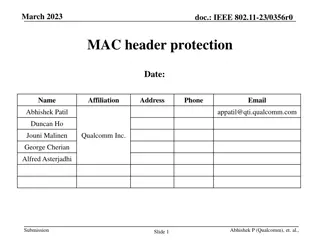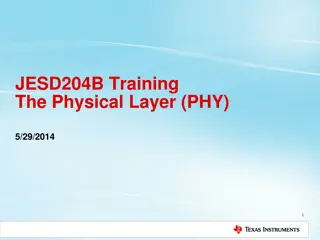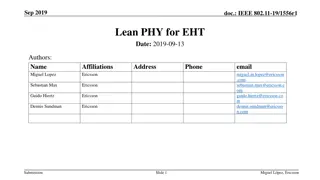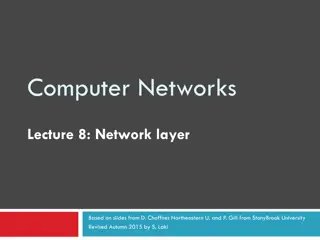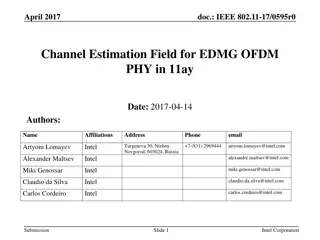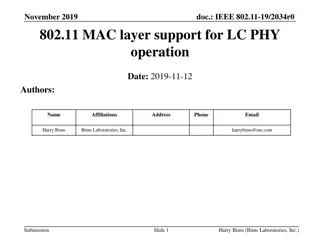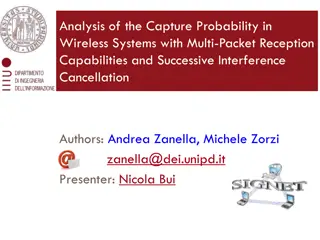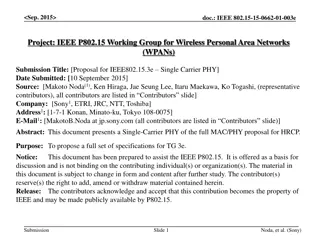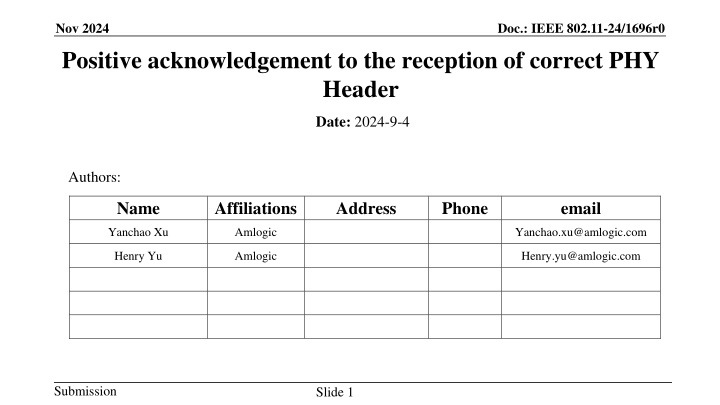
Enhancing MAC Acknowledgement Scheme for IEEE 802.11-24/1696r0
Explore the enhancements proposed for the MAC acknowledgement scheme in IEEE 802.11-24/1696r0 to improve throughput, latency, and reliability. Learn about the current MAC acknowledgement scheme, the need for improvements, and the potential benefits for air medium utilization efficiency.
Download Presentation

Please find below an Image/Link to download the presentation.
The content on the website is provided AS IS for your information and personal use only. It may not be sold, licensed, or shared on other websites without obtaining consent from the author. If you encounter any issues during the download, it is possible that the publisher has removed the file from their server.
You are allowed to download the files provided on this website for personal or commercial use, subject to the condition that they are used lawfully. All files are the property of their respective owners.
The content on the website is provided AS IS for your information and personal use only. It may not be sold, licensed, or shared on other websites without obtaining consent from the author.
E N D
Presentation Transcript
Nov 2024 Positive acknowledgement to the reception of correct PHY Header Doc.: IEEE 802.11-24/1696r0 Date: 2024-9-4 Authors: Name Affiliations Address Phone email Yanchao Xu Amlogic Yanchao.xu@amlogic.com Henry Yu Amlogic Henry.yu@amlogic.com Submission Slide 1
Nov 2024 Doc.: IEEE 802.11-24/1696r0 Introduction According to 11bn PAR, 11bn will provide enhancement to the throughput and latency in non-ideal environment and : at least one mode of operation capable of increasing throughput by 25%, as measured at the MAC data service Access Point, in at least one Signal to Interference and Noise Ratio (SINR) level (Rate-vs-Range), compared to the Extremely High Throughput MAC/PHY operation, and at least one mode of operation capable of reducing latency by 25% for the 95th percentile of the latency distribution compared to the Extremely High Throughput MAC/PHY operation and In this contribution, we discuss a frame exchange sequence scheme to improve the air medium utilization efficiency, which can provide benefits for the low latency and high reliability traffic. Submission Slide 2
Nov 2024 Doc.: IEEE 802.11-24/1696r0 Recap: Current MAC Acknowledgement Scheme In current 802.11, there is only MAC layer acknowledgement scheme for the data traffic, and the ACK/BA will only be responded if at least one of the MPDUs has been correctly received Therefore, for the TxOP holder, its TxOP continuation depends on whether it can receive a positive acknowledgement from one of the corresponding TxOP responders MAC layer acknowledgement scheme won t consider the reception status of the corresponding PPDU s PHY header, Although there are already some MAC level information/parameters in HE/EHT PPDU PHY Header. For example, the BSS Color and STA AID to assist identification of the Tx/Rx devices For the TxOP holder, failure reception of a MAC level acknowledgement during the obtained TxOP may result in an early termination of the TxOP Submission Slide 3
Nov 2024 Doc.: IEEE 802.11-24/1696r0 Recap: Current MAC Acknowledgement Scheme The following figure illustrates an early termination of the TxOP obtained by a TxOP holder. The TxOP holder will take various recovery mechanism after the early termination of the TxOP, depending on implementation. For example, A PIFS recovery. Or, Invocation of a backoff procedure at once, but the maximum new TxOP duration is limited by the remaining time of the last failed TxOP. Or, Invocation of a backoff procedure after the remaining time of the last failed TxOP expires (i.e. the corresponding TXNAV Timer expires) No matter what mechanism the TxOP holder will take, the TxOP Holder needs re-contend the channel, and may initiate the exchange of RTS/CTS, MU-RTS/CTS, ICF/ICR etc. All those introduce additional overhead and do not fully utilize the TxOP obtained by the TxOP Holder Submission Slide 4
Nov 2024 Doc.: IEEE 802.11-24/1696r0 Recap: Current MAC Acknowledgement Scheme What s more, the TxOP is being extended/used for more features in 802.11 The TxOP TXS Sharing mode. An early termination of shared TxOP due to no MAC level acknowledgement may make the whole TxOP sharing procedure fail, or make the TxOP is not fully utilized The eMLSR link s active/listening mode switch is based on TxOP. An early termination of TxOP on the eMLSR link will make the eMLSR link enter the listening mode, and AP needs re-initiate the ICF/ICR exchange to activate this eMLSR link again The DPS (dynamic power save) based on the ICF/IR exchange also may have the same issue as eMLSR link The TxOP level Relay operation under discussion The NPCA/DSO operations on the non-primary channels are also based on TxOP level To be shortly, the early termination of TxOP due to no MAC level acknowledgement can cause the inefficient utilization of the TxOP. So we try to make it possible to continue the TxOP when the conventional MAC level acknowledgement is absent Submission Slide 5
Nov 2024 Doc.: IEEE 802.11-24/1696r0 Positive acknowledgement to reception of correct PHY Header Here a concept is proposed for the data frame exchange sequence that involves acknowledgments in non-TB PPDU, which is to allow a positive acknowledgement (PHY Header ACK) to be responded under the conditions when, An response acknowledgement is solicited in non-TB PPDU. And, The conventional MAC level acknowledgement cannot be invoked (i.e. no correct MPDU is received). And, The corresponding PPDU s PHY header has been received correctly What parts of the PHY header shall be checked is TBD The transmission of the new PHY Header ACK utilizes the same frame exchange sequence as the conventional MAC level acknowledgement. E.g. the SIFS interspace between the reception PPDU and the PHY header ACK The contents/format of the new PHY header ACK is TBD A reception of the new PHY Header ACK will make the TxOP Holder (or the shared TxOP holder) consider the TxOP does not fail Submission Slide 6
Nov 2024 Doc.: IEEE 802.11-24/1696r0 Feasibility study for the PHY Header ACK Comparison of the SNR requirements of the PHY Header parts and the PSDU/Data parts Take the example of the EHT PPDU The pre-EHT fields are all based on BW20. And the L-SIG/U-SIG is BPSK with R=1/2, the EHT-SIG is MCS0/MCS1/MCS3 The PSDU/Data fields can be larger BW > BW20, and can have very high MCS Submission Slide 7
Nov 2024 Doc.: IEEE 802.11-24/1696r0 Feasibility study for the PHY Header ACK Comparison of the SNR requirements of the PHY Header parts and the PSDU/Data parts Take the reference of the spec receiver sensitivity requirements The MCS3 with BW20 can have SNR margin of 17dB/22dB/28dB over the BW20 MCS9/MCS11/MCS13 Actually, in implementation, the SNR gain can be much larger due to implementation higher sensitivity requirements, the duplicated BW20 combined gain for pre-EHT, the 4us PHY OFDM symbol of pre-EHT etc. The larger SNR margin makes it highly possible that the PHY header can be received correctly while the PSDU/Data parts fail to be received correctly Submission Slide 8
Nov 2024 Doc.: IEEE 802.11-24/1696r0 Feasibility study for the PHY Header ACK The contents of the PHY Header fields, The PHY header SIG fields have already their own CRC to help validate their correctness There are already some MAC level parameters/information existing in the PHY header since VHT The BSS Color/STA AID (or the GID/PAID in VHT) in HE/EHT, which can have nearly same functions as the MAC header TA/RA mac address The TXOP_DURATION in HE/EHT, which is to function in the way of the MAC header Duration field Even in S1G, there is NDP CMAC PPDU, which is purely NDP without PSDU/data fields and can work as replacement of the conventional MAC level control frame (CTS/BlockAck/PsPoll/CFEnd etc.) So for the UHR PPDU, it may be possible to put more MAC level information in the UHR (SU) PPDU to help recipient to identify whether a PHY Header ACK can be responded, when the recipient receives a UHR PPDU with no correct MPDU in the PSDU parts Submission Slide 9
Nov 2024 Doc.: IEEE 802.11-24/1696r0 Possible benefits of the new PHY Header ACK The new PHY Header ACK improves the probability that the obtained TxOP is not terminated earlier before the expected end of TxOP A higher utilization efficiency of TxOP is certain to be able to reduce the additional overhead to recovery from a failed TxOP, which indicates a better utilization of air medium. Furthermore, under current TxOP TXS/Multi-AP/Relay features, TxOP can be shared between different Holder/Responder, even between STAs in different BSSes For the more complicated TxOP use scenario, it s more important to keep the original obtained TxOP continuous as far as possible The new PHY Header ACK can offer the TxOP Holder more options to choose from. With the reception of the new PHY Header ACK, in the remaining time of the TxOP, the TxOP Holder can Retransmit to the same TxOP responder immediately without recontending the channel. Invoke its rate adaptation algorithm to determine the transmission rate/MCS to the same TxOP responder. The reception of the new PHY Header ACK can also help provide more information to the rate adaptation algorithm of the TxOP Holder. E.g the reception PPDU s SNR/RSSI etc. Or, if the TxOP Holder is AP, it can also select anther STA as the new TxOP responder. Or, the TxOP Holder can also simply drop this TxOP opportunity In the following pages, we try to simulate a use case to illustrate one of the possible benefits of the new PHY Header ACK Submission Slide 10
Nov 2024 Doc.: IEEE 802.11-24/1696r0 Simulation In our simulations, we choose the scenario of eMLSR frame exchanges as the simulation model Simulation scenario: To simplify the simulation , we use only one single eMLSR link. We can compare the packet delay on the single link between the cases with and without PHY header ACK Submission Slide 11
Nov 2024 Doc.: IEEE 802.11-24/1696r0 Simulation General simulation condition: An eMLSR link established between an AP MLD and a STA MLD, with the capability of BW80 + 1x1 The eMLSR link capability eMLSR transition time: 256us eMLSR padding time: 256us Use the constant rate (or fixed rate) of MCS9 Use the MPDU level packet error rate (MPDU PER), to simulate the error rate of every single MPDU Use the downlink traffic model with low latency characters, Periodical UDP DL traffic: VO_AC, period of 20ms, 1x packet each time, and a delay bound of 5ms (i.e. the packet will be dropped if it cannot be successfully transmitted after 5ms) In our simulation, we use a BlockAck with all 0s bitmap to work as the new PHY Header ACK Figure of Merit: Packet delay of STA1 MLD <-> AP MLD on the single eMLSR link Record the delay of packet that is successfully exchanged Submission Slide 12
Nov 2024 Doc.: IEEE 802.11-24/1696r0 Simulation Firstly, we use the PCAP sniffer file to illustrate the frame exchange sequence difference between the cases with and without new PHY Header ACK For the conventional case (no PHY Header ACK), The Step (1) shows the AP exchanges ICF MU-RTS/CTS to start a TxOP The Step (2) shows the STA receives one correct MPDU in the AMPDU, and responds a BlockAck with non-zero bitmap. AP receives the BlockAck, and continues the TxOP burst transmission. The Step (3) shows the STA does not receive any correct MPDU in the AMPDU, and responds nothing. Then the AP triggers the TxOP recovery, and initiates the ICF MU-RTS/CTS again to trigger frame exchange with STA Submission Slide 13
Nov 2024 Doc.: IEEE 802.11-24/1696r0 Simulation For the case with new PHY Header ACK (All 0s bitmap BlockAck), The Step (1) shows the AP/STA exchanges ICF MU-RTS/CTS to start a TxOP The Step (2) shows the STA receives one correct MPDU in the AMPDU, and responds a BlockAck with non-zero bitmap. AP receives the BlockAck, and continues the TxOP burst transmission. The Step (3) shows the STA does not receive any correct MPDU in the AMPDU, but receives the PHY header correctly, so the STA responds with a BlockAck with all 0s bitmap. AP receives the BlockAck with all 0s bitmap, and continues the TxOP burst transmission without re-initiating the ICF MU-RTS/CTS exchange Submission Slide 14
Nov 2024 Doc.: IEEE 802.11-24/1696r0 Simulation Simulation 1: The traffic model: there is only one period DL UDP traffic in the BSS between AP MLD and STA1 MLD on one eMLSR link, VO_AC, 20ms period, 1x 512B packet each time, and the delay bound of 5ms The simulation result, In the X Axis, the MPDU PER is from 10% ~ 30% These are the typical values that are used in the rate adaptation algorithm The Y Axis shows the average packet delay of the successful transmitted data packet The result shows that the new PHY Header ACK can help keep the packet delay always lower than that of the case without new PHY Header ACK And furthermore, the packet delay is almost constant under the case with PHY Header ACK Submission Slide 15
Nov 2024 Doc.: IEEE 802.11-24/1696r0 Simulation Simulation 2: The traffic model: there is one period DL UDP traffic in the BSS between AP MLD and STA1 MLD on one eMLSR link, VO_AC, 20ms period, 1x 512B packet each time, and the delay bound of 5ms And there is nearly saturated UL UDP traffic in the BSS between AP MLD and STA2 MLD on one eMLSR link BE_AC, TxOP Limit=2.528ms, 1500B packet The simulation result of packet delay of the STA1 MLD <->AP MLD, Still, the result shows that the new PHY Header ACK can help keep the packet delay always lower than that of the case without new PHY Header ACK And for the case with new PHY Header ACK , the deviation of the values of packet delay for different MPDU PER is much smaller than that of the case without new PHY Header ACK Submission Slide 16
Nov 2024 Doc.: IEEE 802.11-24/1696r0 Summary In this contribution, we discuss a frame exchange sequence scheme, in which a positive acknowledgement is defined, for the reception case that PPDU PHY header is received correctly while the PSDU fields are not received correctly (i.e. the conventional MAC ACK/BA is not available) When the TxOP Holder receives the positive acknowledgement to the PHY Header, the TxOP Holder can continue the TxOP We also provide a simulation for the single link eMLSR use scenario, in which benefits are shown for this new frame exchange sequence scheme with PHY Header ACK Submission Slide 17
Nov 2024 Doc.: IEEE 802.11-24/1696r0 SP: Do you agree to define the following frame exchange sequence scheme for the data frame exchange with non-TB response acknowledgement in 11bn SFD? A positive acknowledgement frame is responded for the reception case in which PPDU PHY header is received correctly while the conventional MAC ACK/BA is not available This positive acknowledgement frame is expected to be sent in non-TB PPDU When the TxOP Holder receives the positive acknowledgement to the PHY Header, the TxOP Holder can still continue the TxOP, i.e. the TxOP Holder does not consider the transmission of the corresponding transmitted PPDU fails The details of the related PPDU formats/contents are TBD Including both the PPDU for the positive acknowledgement, and the PPDU that solicits this positive acknowledgement Submission Slide 18
Nov 2024 Doc.: IEEE 802.11-24/1696r0 References [1] IEEE 802.11-14/0571r12 - 11ax Evaluation Methodology Submission Slide 19




